ZHCSDB5B MARCH 2013 – January 2015 DS90UB928Q-Q1
PRODUCTION DATA.
- 1 特性
- 2 应用范围
- 3 说明
- 4 应用图
- 5 修订历史记录
- 6 Pin Configuration and Functions
-
7 Specifications
- 7.1 Absolute Maximum Ratings
- 7.2 ESD Ratings
- 7.3 Recommended Operating Conditions
- 7.4 Thermal Information
- 7.5 DC Electrical Characteristics
- 7.6 AC Electrical Characteristics
- 7.7 Timing Requirements for the Serial Control Bus
- 7.8 Timing Requirements
- 7.9 DC and AC Serial Control Bus Characteristics
- 7.10 Typical Characteristics
-
8 Detailed Description
- 8.1 Overview
- 8.2 Functional Block Diagram
- 8.3
Feature Description
- 8.3.1 High Speed Forward Channel Data Transfer
- 8.3.2 Low Speed Back Channel Data Transfer
- 8.3.3 Backward Compatible Mode
- 8.3.4 Input Equalization
- 8.3.5 Common Mode Filter Pin (CMF)
- 8.3.6 Power Down (PDB)
- 8.3.7 Video Control Signals
- 8.3.8 EMI Reduction Features
- 8.3.9 Built In Self Test (BIST)
- 8.3.10 Internal Pattern Generation
- 8.3.11 Image Enhancement Features
- 8.3.12 Serial Link Fault Detect
- 8.3.13 Oscillator Output
- 8.3.14 Interrupt Pin (INTB)
- 8.3.15 General-Purpose I/O
- 8.3.16 I2S Audio Interface
- 8.4 Device Functional Modes
- 8.5 Programming
- 8.6 Register Maps
- 9 Application and Implementation
- 10Power Supply Recommendations
- 11Layout
- 12器件和文档支持
- 13机械封装和可订购信息
7 Specifications
7.1 Absolute Maximum Ratings(1)(3)
| MIN | MAX | UNIT | |
|---|---|---|---|
| Supply Voltage – VDD33(2) | −0.3 | 4.0 | V |
| Supply Voltage – VDDIO(2) | −0.3 | 4.0 | V |
| LVCMOS I/O Voltage | −0.3 | (VDDIO + 0.3) | V |
| Deserializer Input Voltage | −0.3 | 2.75 | V |
| Junction Temperature | 150 | °C | |
| 48 LLP Package Maximum Power Dissipation Capacity at 25°C | |||
| Storage temperature, Tstg | −65 | 150 | °C |
(1) Stresses beyond those listed under Absolute Maximum Ratings may cause permanent damage to the device. These are stress ratings only, which do not imply functional operation of the device at these or any other conditions beyond those indicated under Recommended Operating Conditions. Exposure to absolute-maximum-rated conditions for extended periods may affect device reliability.
(2) The DS90UB928Q-Q1VDD33 and VDDIO voltages require a specific ramp rate during power up. The power supply ramp time must be less than 1.5 ms with a monotonic rise.
(3) For soldering specifications, see product folder at www.ti.com and SNOA549.
7.2 ESD Ratings
| VALUE | UNIT | |||||
|---|---|---|---|---|---|---|
| V(ESD) | Electrostatic discharge | Human body model (HBM), per AEC Q100-002, all pins(1) | ±8000 | V | ||
| Charged device model (CDM), per AEC Q100-011, all pins | ±1250 | |||||
| Machine model (MM) | ±250 | |||||
| (IEC, powered-up only) RD = 330 Ω, CS = 150 pF |
Air Discharge (Pins 40, 41, 44, and 45) | ±15000 | ||||
| Contact Discharge (Pins 40, 41, 44, and 45) | ±8000 | |||||
| (ISO10605) RD = 330 Ω, CS = 150 pF |
Air Discharge (Pins 40, 41, 44, and 45) | ±15000 | ||||
| Contact Discharge (Pins 40, 41, 44, and 45) | ±8000 | |||||
| (ISO10605) RD = 2 kΩ, CS = 150 pF or 330 pF |
Air Discharge (Pins 40, 41, 44, and 45) | ±15000 | ||||
| Contact Discharge (Pins 40, 41, 44, and 45) | ±8000 | |||||
(1) AEC Q100-002 indicates HBM stressing is done in accordance with the ANSI/ESDA/JEDEC JS-001 specification.
7.3 Recommended Operating Conditions
| MIN | NOM | MAX | UNIT | ||
|---|---|---|---|---|---|
| Supply Voltage (VDD33)(1) | 3.0 | 3.3 | 3.6 | V | |
| LVCMOS Supply Voltage (VDDIO)(1)(2) | Connect VDDIO to 3.3 V and use 3.3-V IOs | 3.0 | 3.3 | 3.6 | V |
| Connect VDDIO to 1.8 V and use 1.8-V IOs | 1.71 | 1.8 | 1.89 | V | |
| Operating Free Air Temperature (TA) |
−40 | +25 | +105 | °C | |
| PCLK Frequency (out of TxCLKOUT±) | 5 | 85 | MHz | ||
| Supply Noise(3) | 100 | mVP-P | |||
(1) The DS90UB928Q-Q1VDD33 and VDDIO voltages require a specific ramp rate during power up. The power supply ramp time must be less than 1.5 ms with a monotonic rise.
(2) VDDIO should not exceed VDD33 by more than 300 mV (VDDIO < VDD33 + 0.3 V).
(3) Supply noise testing was done with minimum capacitors on the PCB. A sinusoidal signal is AC-coupled to the VDD33 and VDDIO supplies with amplitude >100 mVp-p measured at the device VDD33 and VDDIO pins. Bit error rate testing of input to the Ser and output of the Des with 10 meter cable shows no error when the noise frequency on the Ser is less than 50 MHz. The Des on the other hand shows no error when the noise frequency is less than 50 MHz.
7.4 Thermal Information
| THERMAL METRIC(1) | DS90UB928Q-Q1 | UNIT | |
|---|---|---|---|
| RHS (WQFN) | |||
| 48 PINS | |||
| RθJA | Junction-to-ambient thermal resistance | 26.4 | °C/W |
| RθJC(top) | Junction-to-case (top) thermal resistance | 4.4 | |
| RθJB | Junction-to-board thermal resistance | 4.3 | |
| ψJT | Junction-to-top characterization parameter | 0.1 | |
| ψJB | Junction-to-board characterization parameter | 4.3 | |
| RθJC(bot) | Junction-to-case (bottom) thermal resistance | 0.8 | |
(1) For more information about traditional and new thermal metrics, see the IC Package Thermal Metrics application report, SPRA953.
7.5 DC Electrical Characteristics
Over recommended operating supply and temperature ranges unless otherwise specified. (1)(2)(3)| PARAMETER | TEST CONDITIONS | PIN/FREQ. | MIN | TYP | MAX | UNIT | ||
|---|---|---|---|---|---|---|---|---|
| 3.3 V LVCMOS I/O | ||||||||
| VIH | High Level Input Voltage | VDDIO = 3.0 V to 3.6 V | GPIO[3:0], REG_GPIO[8:5], LFMODE, MAPSEL, BISTEN, BISTC, INTB_IN, OEN, OSS_SEL | 2.0 | VDDIO | V | ||
| VIL | Low Level Input Voltage | GND | 0.8 | V | ||||
| IIN | Input Current | VIN = 0 V or VIN = 3.0 V to 3.6 V | −10 | ±1 | +10 | μA | ||
| VIH | High Level Input Voltage | (4) | PDB | 2.0 | VDDIO | V | ||
| VIL | Low Level Input Voltage | GND | 0.7 | V | ||||
| IIN | Input Current | VIN = 0 V or VIN = 3.0 V to 3.6 V (4) |
−10 | ±1 | +10 | μA | ||
| VOH | HIGH Level Output Voltage | IOH = -4 mA | GPIO[3:0], REG_GPIO[8:5], MCLK, I2S_WC, I2S_CLK, I2S_D[A:D], LOCK, PASS | 2.4 | VDDIO | V | ||
| VOL | LOW Level Output Voltage | IOL = +4 mA | 0 | 0.4 | V | |||
| IOS | Output Short Circuit Current | VOUT = 0 V(5) | −55 | mA | ||||
| IOZ | Tri-state Output Current | VOUT = 0 V or VDDIO, PDB = L | −20 | +20 | μA | |||
| 1.8 V LVCMOS I/O | ||||||||
| VIH | High Level Input Voltage | VDDIO = 1.71 V to 1.89 V | GPIO[3:0], REG_GPIO[8:5], LFMODE, MAPSEL, BISTEN, BISTC, INTB_IN, OEN, OSS_SEL | 0.65 * VDDIO | VDDIO | V | ||
| VIL | Low Level Input Voltage | 0 | 0.35 * VDDIO | V | ||||
| IIN | Input Current | VIN = 0 V or VIN = 1.71 V to 1.89 V | -10 | 10 | μA | |||
| VOH | HIGH Level Output Voltage | IOH = -4 mA | GPIO[3:0], REG_GPIO[8:5], MCLK, I2S_WC, I2S_CLK, I2S_D[A:D], LOCK, PASS | VDDIO - 0.45 | VDDIO | V | ||
| VOL | LOW Level Output Voltage | IOL = +4 mA | 0 | 0.45 | V | |||
| IOS | Output Short Circuit Current | VOUT = 0 V(5) | -35 | mA | ||||
| IOZ | TRI-STATE® Output Current | VOUT = 0 V or VDDIO, PDB = L, | -20 | 20 | μA | |||
| FPD-LINK LVDS OUTPUT | ||||||||
| VOD | Output Voltage Swing (single-ended) | RL = 100 Ω | TxCLK±, TxOUT[3:0]± | 350 | 450 | 600 | mV | |
| VODp-p | Differential Output Voltage | 900 | mV | |||||
| ΔVOD | Output Voltage Unbalance | 1 | 50 | mV | ||||
| VOS | Common Mode Voltage | 1.0 | 1.2 | 1.5 | V | |||
| ΔVOS | Offset Voltage Unbalance | 1 | 50 | mV | ||||
| IOS | Output Short Circuit Current | VOUT = GND | -5 | mA | ||||
| IOZ | Output TRI-STATE® Current | OEN = GND, VOUT = VDDIO or GND, 0.8 V≤VIN≤1.6 V | -500 | 500 | μA | |||
| FPD-LINK III RECEIVER | ||||||||
| VTH | Input Threshold High | VCM = 2.1 V (Internal VBIAS) | RIN± | 50 | mV | |||
| VTL | Input Threshold Low | -50 | mV | |||||
| VID | Input Differential Threshold | 100 | mV | |||||
| VCM | Common-mode Voltage | 2.1 | V | |||||
| RT | Internal Termination Resistance (Differential) | 80 | 100 | 120 | Ω | |||
| LOOP-THROUGH MONITOR OUTPUT | ||||||||
| VODp-p | Differential Output Voltage | RL = 100 Ω | CMLOUTP, CMLOUTN | 360 | mV | |||
| SUPPLY CURRENT | ||||||||
| IDD1 | Supply Current RL = 100Ω, PCLK = 85MHz |
Checkerboard Pattern | VDD33= 3.6 V | 190 | 250 | mA | ||
| IDDIO1 | VDDIO = 3.6 V | 0.1 | 1 | mA | ||||
| VDDIO = 1.89 V | 0.1 | 1 | mA | |||||
| IDD2 | Random Pattern | VDD33= 3.6 V | 185 | mA | ||||
| IDDIO2 | VDDIO = 3.6 V | 0.1 | mA | |||||
| VDDIO = 1.89 V | 0.1 | mA | ||||||
| IDDZ | Supply Current — Power Down | PDB = 0 V, All other LVCMOS inputs = 0 V | VDD33 = 3.6 V | 3 | 8 | mA | ||
| IDDIOZ | VDDIO = 3.6 V | 100 | 500 | μA | ||||
| VDDIO = 1.89 V | 50 | 250 | μA | |||||
(1) The Electrical Characteristics tables list ensured specifications under the listed Recommended Operating Conditions except as otherwise modified or specified by the Electrical Characteristics conditions and/or notes. Typical specifications are estimations only and are not ensured.
(2) Typical values represent most likely parametric norms at VDD33 = 3.3 V, VDDIO = 1.8 V or 3.3 V, Ta = +25°C, and at the Recommended Operating Conditions at the time of product characterization and are not ensured.
(3) Current into device pins is defined as positive. Current out of a device pin is defined as negative. Voltages are referenced to ground except VOD and ΔVOD, which are differential voltages.
(4) PDB is specified to 3.3 V LVCMOS only and must be driven or pulled up to VDD33 or to VDDIO ≥ 3.0 V.
(5) IOS is not specified for an indefinite period of time. Do not hold in short circuit for more than 500 ms or part damage may result.
7.6 AC Electrical Characteristics
Over recommended operating supply and temperature ranges unless otherwise specified. (1)(2)(3)| PARAMETER | TEST CONDITIONS | PIN/FREQ. | MIN | TYP | MAX | UNIT | |
|---|---|---|---|---|---|---|---|
| GPIO | |||||||
| tGPIO,FC | GPIO Pulse Width, Forward Channel | See (4) | GPIO[3:0], PCLK = 5MHz to 85MHz | >2/PCLK | s | ||
| tGPIO,BC | GPIO Pulse Width, Back Channel | See (4) | GPIO[3:0] | 20 | µs | ||
| RESET | |||||||
| tLRST | PDB Reset Low Pulse | See (4) | PDB | 2 | ms | ||
| LOOP-THROUGH MONITOR OUTPUT | |||||||
| EW | Differential Output Eye Opening Width | RL = 100 Ω, Jitter freq > f/40 | RIN± | >0.4 | UI | ||
| EH | Differential Output Eye Height | >300 | mV | ||||
| FPD-LINK LVDS OUTPUT | |||||||
| tTLHT | Low to High Transition Time | RL = 100 Ω | TxCLK±, TxOUT[3:0]± | 0.25 | 0.5 | ns | |
| tTHLT | High to Low Transition Time | 0.25 | 0.5 | ns | |||
| tDCCJ | Cycle-to-Cycle Output Jitter | PCLK = 5 MHz | TxCLK± | 170 | 275 | ps | |
| PCLK = 85 MHz | 35 | 55 | |||||
| tTTPn | Transmitter Pulse Position | 5 MHz≤PCLK≤85 MHz n=[6:0] for bits [6:0] See Figure 13 |
TxOUT[3:0]± | 0.5 + n | UI | ||
| ΔtTTP | Offset Transmitter Pulse Position (bit 6 - bit 0) | PCLK = 85 MHz | <0.1 | UI | |||
| tDD | Delay Latency | 147*T | T | ||||
| tTPDD | Power Down Delay Active to OFF | 900 | µs | ||||
| tTXZR | Enable Delay OFF to Active | 6 | ns | ||||
| FPD-LINK III INPUT | |||||||
| tDDLT | Lock Time(4) | 5 MHz≤PCLK≤85 MHz | RIN±, LOCK | 6 | 40 | ms | |
| LVCMOS OUTPUTS | |||||||
| tCLH | Low to High Transition Time | CL = 8 pF | LOCK, PASS | 3 | 7 | ns | |
| tCHL | High to Low Transition Time | 2 | 5 | ns | |||
| BIST MODE | |||||||
| tPASS | BIST PASS Valid Time | PASS | 800 | ns | |||
| I2S TRANSMITTER | |||||||
| tJ | Clock Output Jitter | MCLK | 2 | ns | |||
| TI2S | I2S Clock Period Figure 10, (4)(5) |
PCLK=5 MHz to 85 MHz | I2S_CLK, PCLK = 5MHz to 85MHz | >2/PCLK or >77 | ns | ||
| THC | I2S Clock High Time Figure 10, (5) |
I2S_CLK | 0.35 | TI2S | |||
| TLC | I2S Clock Low Time Figure 10, (5) |
I2S_CLK | 0.35 | TI2S | |||
| tsr | I2S Set-up Time | I2S_WC I2S_D[A:D] |
0.2 | TI2S | |||
| thr | I2S Hold Time | I2S_WC I2S_D[A:D] |
0.2 | TI2S | |||
(1) The Electrical Characteristics tables list ensured specifications under the listed Recommended Operating Conditions except as otherwise modified or specified by the Electrical Characteristics conditions and/or notes. Typical specifications are estimations only and are not ensured.
(2) Typical values represent most likely parametric norms at VDD33 = 3.3 V, VDDIO = 1.8 V or 3.3 V, Ta = +25°C, and at the Recommended Operating Conditions at the time of product characterization and are not ensured.
(3) Current into device pins is defined as positive. Current out of a device pin is defined as negative. Voltages are referenced to ground except VOD and ΔVOD, which are differential voltages.
(4) Specification is ensured by design and is not tested in production.
(5) I2S specifications for tLC and tHC pulses must each be greater than 1 PCLK period to ensure sampling and supersedes the 0.35*TI2S_CLK requirement. tLC and tHC must be longer than the greater of either 0.35*TI2S_CLK or 2*PCLK.
7.7 Timing Requirements for the Serial Control Bus
Over 3.3-V supply and temperature ranges unless otherwise specified. (1)(2)| MIN | TYP | MAX | UNIT | |||
|---|---|---|---|---|---|---|
| fSCL | SCL Clock Frequency | Standard Mode | 0 | 100 | kHz | |
| Fast Mode | 0 | 400 | kHz | |||
| tLOW | SCL Low Period | Standard Mode | 4.7 | µs | ||
| Fast Mode | 1.3 | µs | ||||
| tHIGH | SCL High Period | Standard Mode | 4.0 | µs | ||
| Fast Mode | 0.6 | µs | ||||
| tHD;STA | Hold time for a start or a repeated start condition (3) |
Standard Mode | 4.0 | µs | ||
| Fast Mode | 0.6 | µs | ||||
| tSU:STA | Set Up time for a start or a repeated start condition (3) |
Standard Mode | 4.7 | µs | ||
| Fast Mode | 0.6 | µs | ||||
| tHD;DAT | Data Hold Time (3) |
Standard Mode | 0 | 3.45 | µs | |
| Fast Mode | 0 | 0.9 | µs | |||
| tSU;DAT | Data Set Up Time (3) |
Standard Mode | 250 | ns | ||
| Fast Mode | 100 | ns | ||||
| tSU;STO | Set Up Time for STOP Condition (3) |
Standard Mode | 4.0 | µs | ||
| Fast Mode | 0.6 | µs | ||||
| tBUF | Bus Free Time Between STOP and START (3) |
Standard Mode | 4.7 | µs | ||
| Fast Mode | 1.3 | µs | ||||
| tr | SCL & SDA Rise Time, (3) |
Standard Mode | 1000 | ns | ||
| Fast Mode | 300 | ns | ||||
| tf | SCL & SDA Fall Time, (3) |
Standard Mode | 300 | ns | ||
| Fast mode | 300 | ns | ||||
(1) The Electrical Characteristics tables list ensured specifications under the listed Recommended Operating Conditions except as otherwise modified or specified by the Electrical Characteristics conditions and/or notes. Typical specifications are estimations only and are not ensured.
(2) Typical values represent most likely parametric norms at VDD33 = 3.3 V, VDDIO = 1.8 V or 3.3 V, TA = +25°C, and at the Recommended Operating Conditions at the time of product characterization and are not ensured.
(3) Specification is ensured by design and is not tested in production.
7.8 Timing Requirements
| MIN | NOM | MAX | UNIT | |||
|---|---|---|---|---|---|---|
| tR | SDA RiseTime – READ | SDA, RPU = 10 kΩ, Cb ≤ 400 pF, Figure 9 | 430 | ns | ||
| tF | SDA Fall Time – READ | 20 | ns | |||
| tSU;DAT | Set Up Time — READ | Figure 9 | 560 | ns | ||
| tHD;DAT | Hold Up Time — READ | Figure 9 | 615 | ns | ||
7.9 DC and AC Serial Control Bus Characteristics
Over 3.3-V supply and temperature ranges unless otherwise specified. (1)(2)(3)| PARAMETER | TEST CONDITIONS | MIN | TYP | MAX | UNIT | |
|---|---|---|---|---|---|---|
| VIH | Input High Level | SDA and SCL | 0.7* VDDIO |
VDD33 | V | |
| VIL | Input Low Level Voltage | SDA and SCL | GND | 0.3* VDD33 |
V | |
| VHY | Input Hysteresis | >50 | mV | |||
| VOL | SDA or SCL, IOL = 1.25 mA | 0 | 0.36 | V | ||
| Iin | SDA or SCL, Vin = VDDIO or GND | -10 | +10 | µA | ||
| tSP | Input Filter | 50 | ns | |||
| Cin | Input Capacitance | SDA or SCL | <5 | pF | ||
(1) The Electrical Characteristics tables list specifications under the listed Recommended Operating Conditions except as otherwise modified or specified by the Electrical Characteristics conditions and/or notes. Typical specifications are estimations only and are not ensured.
(2) Typical values represent most likely parametric norms at VDD33 = 3.3 V, VDDIO = 1.8 V or 3.3 V, TA = +25°C, and at the Recommended Operating Conditions at the time of product characterization and are not ensured.
(3) Current into device pins is defined as positive. Current out of a device pin is defined as negative. Voltages are referenced to ground except VOD and ΔVOD, which are differential voltages.
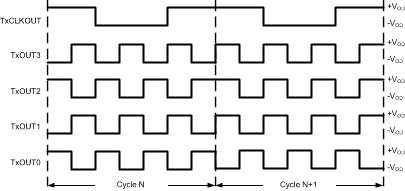 Figure 1. Checkerboard Data Pattern
Figure 1. Checkerboard Data Pattern
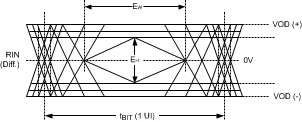 Figure 2. CML Output Driver
Figure 2. CML Output Driver
 Figure 3. LVCMOS Transition Times
Figure 3. LVCMOS Transition Times
 Figure 4. Latency Delay
Figure 4. Latency Delay
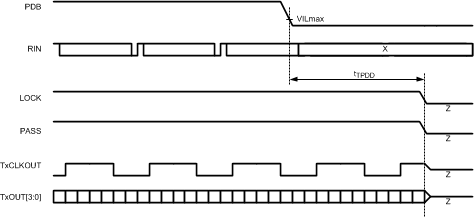 Figure 5. FPD-Link & LVCMOS Power Down Delay
Figure 5. FPD-Link & LVCMOS Power Down Delay
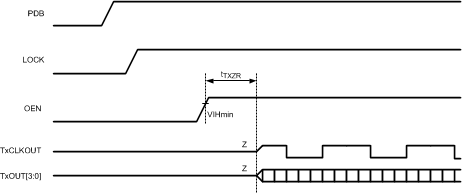 Figure 6. FPD-Link Outputs Enable Delay
Figure 6. FPD-Link Outputs Enable Delay
 Figure 7. CML PLL Lock Time
Figure 7. CML PLL Lock Time
 Figure 8. FPD-Link III Receiver DC VTH/VTL Definition
Figure 8. FPD-Link III Receiver DC VTH/VTL Definition
 Figure 9. Output Data Valid (Setup and Hold) Times
Figure 9. Output Data Valid (Setup and Hold) Times
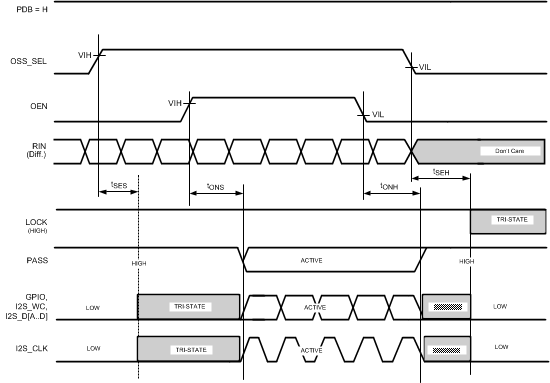 Figure 10. Output State (Setup and Hold) Times
Figure 10. Output State (Setup and Hold) Times
 Figure 11. Input Transition Times
Figure 11. Input Transition Times
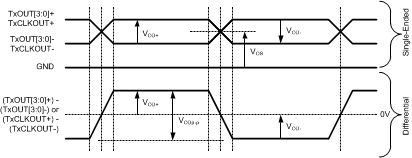 Figure 12. FPD-Link Single-Ended and Differential Waveforms
Figure 12. FPD-Link Single-Ended and Differential Waveforms
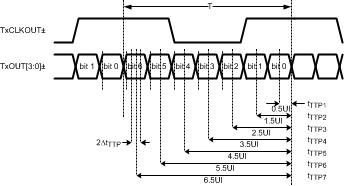 Figure 13. FPD-Link Transmitter Pulse Positions
Figure 13. FPD-Link Transmitter Pulse Positions
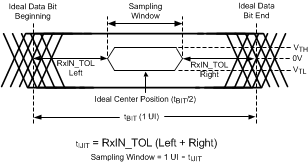 Figure 14. Receiver Input Jitter Tolerance
Figure 14. Receiver Input Jitter Tolerance
 Figure 15. BIST PASS Waveform
Figure 15. BIST PASS Waveform
 Figure 16. Serial Control Bus Timing Diagram
Figure 16. Serial Control Bus Timing Diagram
7.10 Typical Characteristics
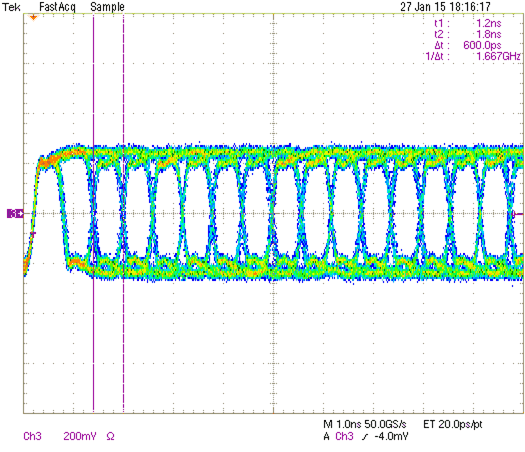 Figure 17. Serializer Output Stream with 48MHz Input Clock
Figure 17. Serializer Output Stream with 48MHz Input Clock
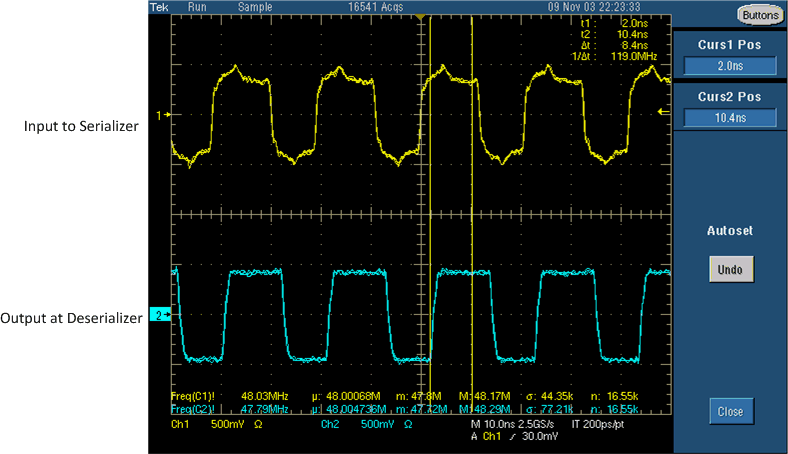 Figure 18. 48MHz Clock at Serializer and Deserializer
Figure 18. 48MHz Clock at Serializer and Deserializer